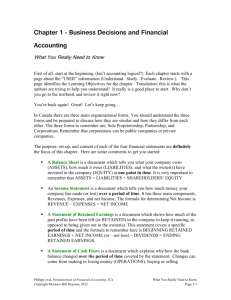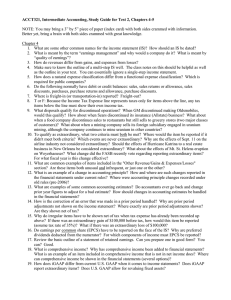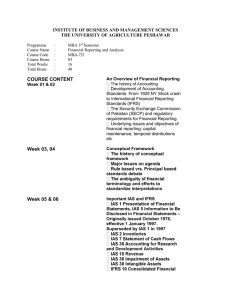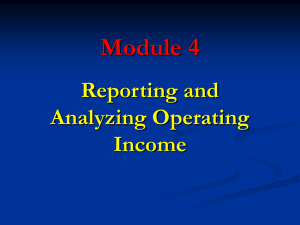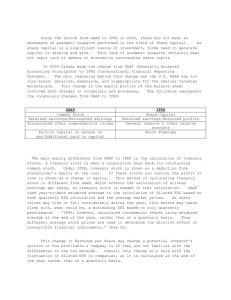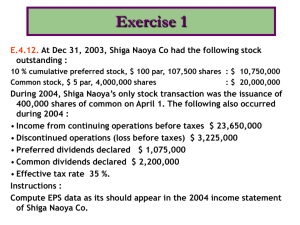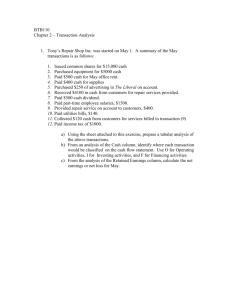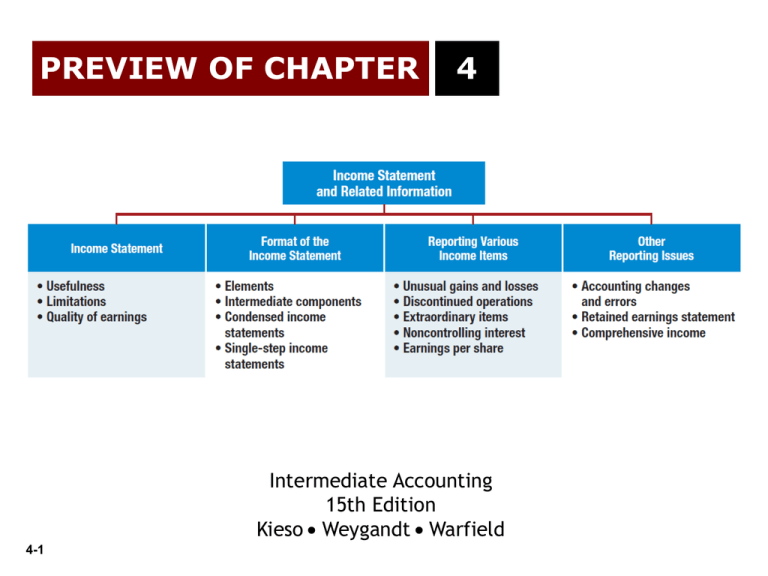
PREVIEW OF CHAPTER
4
Intermediate Accounting
15th Edition
Kieso Weygandt Warfield
4-1
4
Income Statement and
Related Information
LEARNING OBJECTIVES
After studying this chapter, you should be able to:
4-2
1.
Understand the uses and limitations of an
income statement.
5.
Identify where to report earnings per
share information.
2.
Describe the content and format of the
income statement.
6.
Understand the reporting of accounting
changes and errors.
3.
Prepare an income statement.
7.
Prepare a retained earnings statement.
4.
Explain how to report various income
items.
8.
Explain how to report other
comprehensive income.
Income Statement
Usefulness
Evaluate past performance.
4-3
Predicting future performance.
Help assess the risk or uncertainty of
achieving future cash flows.
LO 1 Understand the uses and limitations of an income statement.
Income Statement
Limitations
Companies omit items that cannot be
measured reliably.
4-4
Income is affected by the accounting
methods employed.
Income measurement involves
judgment.
LO 1 Understand the uses and limitations of an income statement.
Income Statement
Quality of Earnings
Companies have incentives to manage income to meet or
beat Wall Street expectations, so that
market price of stock increases and
value of stock options increase.
Quality of earnings is reduced if earnings management
results in information that is less useful for predicting future
earnings and cash flows.
4-5
LO 1 Understand the uses and limitations of an income statement.
4
Income Statement and
Related Information
LEARNING OBJECTIVES
After studying this chapter, you should be able to:
4-6
1.
Understand the uses and limitations of an
income statement.
5.
Identify where to report earnings per
share information.
2.
Describe the content and format of the
income statement.
6.
Understand the reporting of accounting
changes and errors.
3.
Prepare an income statement.
7.
Prepare a retained earnings statement.
4.
Explain how to report various income
items.
8.
Explain how to report other
comprehensive income.
Format of the Income Statement
Elements of the Income Statement
Revenues – Inflows or other enhancements of assets or
settlements of its liabilities that constitute the entity’s ongoing
major or central operations.
Examples of Revenue Accounts
4-7
Sales
Dividend
Fee
Rent
Interest
LO 2 Describe the content and format of the income statement.
Format of the Income Statement
Elements of the Income Statement
Expenses – Outflows or other using-up of assets or
incurrences of liabilities that constitute the entity’s ongoing
major or central operations.
Examples of Expense Accounts
4-8
Cost of goods sold
Rent
Depreciation
Salaries and wages
Interest
Taxes
LO 2 Describe the content and format of the income statement.
Format of the Income Statement
Elements of the Income Statement
Gains – Increases in equity (net assets) from peripheral or
incidental transactions.
Losses - Decreases in equity (net assets) from peripheral or
incidental transactions.
Gains and losses can result from
4-9
sale of investments or plant assets,
settlement of liabilities,
write-offs of assets.
LO 2 Describe the content and format of the income statement.
4
Income Statement and
Related Information
LEARNING OBJECTIVES
After studying this chapter, you should be able to:
1.
Understand the uses and limitations of an
income statement.
5.
Identify where to report earnings per
share information.
2.
Describe the content and format of the
income statement.
6.
Understand the reporting of accounting
changes and errors.
3.
Prepare an income statement.
7.
Prepare a retained earnings statement.
4.
Explain how to report various income
items.
8.
Explain how to report other
comprehensive income.
4-10
Format of the Income Statement
Intermediate Components
Format referred to as multiple-step income
statement.
4-11
Separates operating transactions from nonoperating
transactions.
Matches costs and expenses with related revenues.
Highlights certain components of income that analysts
use assessing financial performance.
LO 3 Prepare an income statement.
Intermediate Components
Common for companies to present some or all of the
following sections and totals within the income statement.
1. Operating section
2. Nonoperating section
3. Income tax
4. Discontinued operations
5. Extraordinary items
6. Noncontrolling interest
7. Earnings per share
4-12
LO 3 Prepare an income statement.
Multiple-Step
CABRERA COMPANY
Income Statement
For The Year Ended December 31, 2014
1. Operating Section
2. Nonoperating
Section
3. Income tax
4-13
Illustration 4-2
Condensed Income Statements
Illustration 4-3
4-14
LO 3 Prepare an income statement.
Format of the Income Statement
Single-Step Income
Statements
Revenues
Expenses
SingleStep
Net Income
No implication that one
type of revenue or
expense item has priority
over another.
Illustration 4-5
4-15
LO 3 Prepare an income statement.
TOP LINE
OR BOTTOM
LINE?
WHAT’S
YOUR
PRINCIPLE
The importance of components of income, as well as the bottom line, is illustrated in the recent
case of Chipotle. Its stock had climbed fourfold in five years and for good reason. The company
had been reporting surprisingly high bottom-line for revenues. The stock fell 21 percent, from
$404 to $317, in a day. And Chipotle was not alone. Six in 10 large companies reported results in
that same quarter that missed revenue targets. In response to the bad revenue news,
Priceline.com fell $117 to $562 after reporting revenue that was lower than analysts had
expected. The story has been the same for dozens of companies across industries, from Coach,
a luxury goods retailer, to Boston Scientific, which sells medical devices, to glass-container
maker Owens-Illinois. The recent focus on the top line, revenue, arises because market
expectations for revenues do not seem to jive with the companies’ optimistic profit picture. For
example, revenues are expected to drop by about 2 percent in 2013 for companies in the S&P
500. And while companies might report a income and investors were clamoring to buy. However,
in a recent month, that pattern was broken—that is, Chipotle posted solid earnings, but investors
sold. The reason? Analysts attribute the sell-off to Chipotle missing its target surprise in earnings,
analysts will be focusing on revenues. Companies have been able to cut costs to compensate—
laying off workers, squeezing remaining staff, and using technology to run more efficiently—but
there’s a limit to how much you can squeeze your workers and use technology to produce more.
U.S. companies are just about as lean as any time in history. As one analyst noted (in this
economic environment), “you won’t be able to grow earnings much faster than revenue. . . .
Analysts will have to revise down their earnings.” So watch the top line, as well as the bottom
line. Source: Associated Press, “Why Some Stocks Are Sinking Despite Big Profits,” The New
York Times (August 12, 2012).
4-16
LO 3 Prepare an income statement.
Format of the Income Statement
Question
The single-step income statement emphasizes
a. the gross profit figure.
b. total revenues and total expenses.
c. extraordinary items more than it is emphasized in the
multiple-step income statement.
d. the various components of income from continuing
operations.
4-17
LO 3 Prepare an income statement.
Format of the Income Statement
Illustration (E4-5): Prepare a
income statement from the data
below using the multiple-step
form.
Administrative expense:
Officers' salaries
For the year ended Dec. 31, 2014
Sales
$
Cost of goods sold
96,500
60,570
Gross profit
35,930
Operating Expenses:
$
4,900
Selling expense
Depreciation
3,960
Administrative exense
Cost of goods sold
60,570
Rent revenue
17,230
Selling expense:
17,150
8,860
Total operating expenses
26,010
Income from operations
9,920
Other revenue (expense):
Freight-out
2,690
Rent revenue
17,230
Sales commissions
7,980
Interest expense
(1,860)
Depreciation
6,480
Sales
4-18
Income Statement
96,500
Income tax
9,070
Interest expense
1,860
Advance slide in presentation
mode to reveal answers.
Total other
15,370
Income before tax
25,290
Income tax
Net income
9,070
$
16,220
LO 3 Prepare an income statement.
Format of the Income Statement
Question
A separation of operating and non operating activities of a
company exists in
a. both a multiple-step and single-step income statement.
b. a multiple-step but not a single-step income statement.
c. a single-step but not a multiple-step income statement.
d. neither a single-step nor a multiple-step income
statement.
4-19
LO 3 Prepare an income statement.
4
Income Statement and
Related Information
LEARNING OBJECTIVES
After studying this chapter, you should be able to:
1.
Understand the uses and limitations of an
income statement.
5.
Identify where to report earnings per
share information.
2.
Describe the content and format of the
income statement.
6.
Understand the reporting of accounting
changes and errors.
3.
Prepare an income statement.
7.
Prepare a retained earnings statement.
4.
Explain how to report various income
items.
8.
Explain how to report other
comprehensive income.
4-20
Reporting Various Income Items
Companies are required to report unusual and irregular items
as part of net income so users can better determine the longrun earning power of the company.
These income items fall into four general categories:
1. Unusual gains and losses.
2. Discontinued operations.
3. Extraordinary items.
Modified all
inclusive concept
4. Noncontrolling interest.
4-21
LO 4 Explain how to report various income items.
Reporting Various Income Items
Unusual Gains and Losses
The following items may need separate disclosure in the income
statement.
1. Losses on the write-down or write-off of assets.
2. Gains or losses from exchange or translation of foreign
currencies.
3. Restructuring charges.
4. Other gains or losses from sale or abandonment of property,
plant, or equipment used in the business.
5. Effects of a strike.
6. Adjustment of accruals on long-term contracts.
4-22
LO 4
Reporting Various Income Items
Unusual Gains and Losses
4-23
Illustration 4-6
Number of Irregular Items
Reported in a Recent Year
by 500 Large Companies
LO 4 Explain how to report various income items.
Reporting Various Income Items
Discontinued Operations
Occurs when,
(1) company eliminates the results of operations of a
component of the business, and
(2) there is no significant involvement in that component
after the disposal transaction.
Amounts reported “net of tax.”
4-24
LO 4 Explain how to report various income items.
Discontinued Operations
Illustration: KC Products Inc., a highly diversified company, decides
to discontinue its electronics division. During the current year, the
electronics division lost $300,000 (net of tax). Multiplex sold the
division at the end of the year at a loss of $500,000 (net of tax). Show
how the discontinued operations would be reported on the income
statement for KC Products.
Illustration 4-8
4-25
Income from continuing operations
Discontinued operations:
Loss from operations, net of tax
Loss on disposal, net of tax
Total loss on discontinued operations
$20,000,000
Net income
$19,200,000
Advance slide in presentation
mode to reveal answers.
300,000
500,000
504,000
LO 4
Discontinued Operations
Illustration 4-9
Discontinued
Operations
are reported
after “Income
from continuing
operations.”
Without a
discontinued
operations this
line would be
“net income.”
4-26
Discontinued Operations
Intraperiod Tax Allocation
► The allocation of tax within a period.
► Helps users understand the impact of income taxes on
the various components of net income.
► Intraperiod tax allocation is used for:
(1) income from continuing operations,
(2) discontinued operations, and
(3) extraordinary items.
4-27
LO 4 Explain how to report various income items.
Discontinued Operations
Discontinued Operations (Gain)
Illustration: Schindler Co. has income before income tax of
$250,000. It has a gain of $100,000 from a discontinued operation.
Assuming a 30 percent income tax rate, Schindler presents the
following information on the income statement.
Illustration 4-10
4-28
LO 4 Explain how to report various income items.
Discontinued Operations
Discontinued Operations (Loss)
Illustration: Schindler Co. has income before income tax of
$250,000. It suffers a loss from discontinued operations of $100,000.
Assuming a 30 percent tax rate, Schindler presents the income tax on
the income statement as shown
Illustration 4-11
4-29
LO 4 Explain how to report various income items.
Reporting Various Income Items
Extraordinary items are nonrecurring material items that
differ significantly from a company’s typical business activities.
Extraordinary item must meet both of the following criteria:
Unusual nature and
Infrequently of occurrence
Company must consider the environment in which it operates.
Amount reported “net of tax.”
4-30
LO 4 Explain how to report various income items.
Extraordinary Items
Are these items Extraordinary?
4-31
(a)
A large portion of a tobacco manufacturer’s crops are
destroyed by a hail storm. Severe damage from hail
storms in the locality where the manufacturer grows
tobacco is rare.
(b)
A citrus grower's Florida crop is damaged by frost.
(c)
A company sells a block of common stock of a
publicly traded company. The block of shares, which
represents less than 10% of the publicly-held
company, is the only security investment the company
has ever owned.
Advance slide in presentation
mode to reveal answers.
YES
NO
YES
LO 4 Explain how to report various income items.
Extraordinary Items
Are these items Extraordinary?
4-32
(d)
A large diversified company sells a block of shares
from its portfolio of securities which it has acquired
for investment purposes. This is the first sale from its
portfolio of securities.
(e)
An earthquake destroys one of the oil refineries
owned by a large multi-national oil company.
Earthquakes are rare in this geographical location.
(f)
A company experiences a material loss in the
repurchase of a large bond issue that has been
outstanding for 3 years. The company regularly
repurchases bonds of this nature.
Advance slide in presentation
mode to reveal answers.
NO
YES
NO
LO 4
Extraordinary Items
Extraordinary Gains
Illustration: Schindler Co. has income before income tax and
extraordinary item of $250,000. It has an extraordinary gain of
$100,000 from a condemnation settlement received on one its
properties (30 percent tax rate). Income statement presentation:
Illustration 4-13
4-33
LO 4 Explain how to report various income items.
Extraordinary Items
Extraordinary Losses
Illustration: Schindler Co. has income before income tax and
extraordinary item of $250,000. It suffers an extraordinary loss from a
major casualty of $100,000 (30 percent tax rate). The loss provides a
positive tax benefit. Income statement presentation:
Illustration 4-14
4-34
LO 4 Explain how to report various income items.
Illustration 4-9
Extraordinary
Items are
reported after
“Income from
continuing
operations”
and after
“Discontinued
Operations.”
Illustration 4-19
4-35
Reporting Various Income Items
Question
Irregular transactions such as discontinued operations and
extraordinary items should be reported separately in
4-36
a.
both a single-step and multiple-step income
statement.
b.
a single-step income statement only.
c.
a multiple-step income statement only.
d.
neither a single-step nor a multiple-step income
statement.
LO 4 Explain how to report various income items.
WHAT’S
EXTRAORDINARY
YOUR PRINCIPLE
TIMES
No event better illustrates the difficulties of determining whether a transaction meets the
definition of extraordinary than the financial impacts of the terrorist attack on the World
Trade Center on September 11, 2001. To many, this event, which resulted in the tragic loss
of lives, jobs, and in some cases entire businesses, clearly meets the criteria for unusual
and infrequent. For example, in the wake of the terrorist attack that destroyed the World
Trade Center and turned much of lower Manhattan including Wall airline industry as an
example. What portion of the airlines’ losses after September 11 was related to the terrorist
attack, and what portion was due to the ongoing recession? Also, the FASB did not want
companies to use the attack as a reason for reporting as extraordinary some losses that
had little direct relationship to the attack. Indeed, energy company Street into a war zone,
airlines, insurance companies, and other businesses recorded major losses due to
property damage, business disruption, and suspension of airline travel and of securities
trading. But, to the surprise of many, the FASB did not permit extraordinary item reporting
for losses arising from the terrorist attacks. The reason? After much deliberation, the
Emerging Issues Task Force (EITF) of the FASB decided that measurement of the possible
loss was too difficult. Take the AES and shoe retailer Footstar, who both were
experiencing profit pressure before 9/11, put some of the blame for their poor performance
on the attack. Source: Julie Creswell, “Bad News Bearers Shift the Blame,” Fortune
(October 15, 2001), p. 44.
4-37
Reporting Various Income Items
Noncontrolling Interest
When a company owns substantial interests (generally > 50%)
in another company, GAAP requires that the financial
statements of both companies be consolidated together into
one set of financials.
Noncontrolling interest is the portion of equity (net assets)
interest in a subsidiary not attributable to the parent company.
4-38
LO 4 Explain how to report various income items.
Noncontrolling Interest
Illustration: Assume that Coca-Cola acquires 70 percent of the
outstanding stock of Koch Company. Because Coca-Cola owns
more than 50 percent of Koch, it consolidates Koch’s financial results
with its own. GAAP requires that net income be allocated to the
controlling and noncontrolling interest.
Illustration 4-16
Presentation of Noncontrolling Interest
The noncontrolling interest amounts are not an expense or dividend, but
are allocations of net income (loss) to the noncontrolling interest.
4-39
LO 4 Explain how to report various income items.
Illustration 4-9
Noncontrolling
interest
amounts are
allocations of net
income (loss) to
the
noncontrolling
interest.
Illustration 4-19
4-40
Summary of Various Income
Illustration 4-17
4-41
LO 4 Explain how to report various income items.
4
Income Statement and
Related Information
LEARNING OBJECTIVES
After studying this chapter, you should be able to:
1.
Understand the uses and limitations of an
income statement.
5.
Identify where to report earnings per
share information.
2.
Describe the content and format of the
income statement.
6.
Understand the reporting of accounting
changes and errors.
3.
Prepare an income statement.
7.
Prepare a retained earnings statement.
4.
Explain how to report various income
items.
8.
Explain how to report other
comprehensive income.
4-42
Reporting Various Income Items
Earnings per Share
Net Income - Preferred Dividends
Weighted Average of Common Shares Outstanding
A significant business indicator.
Measures the dollars earned by each share of common
stock.
4-43
Must be disclosed on the income statement.
LO 5 Identify where to report earnings per share information.
Earnings per Share
Illustration: Lancer, Inc. reports net income of $350,000. It
declares and pays preferred dividends of $50,000 for the year.
The weighted-average number of common shares outstanding
during the year is 100,000 shares. Lancer computes earnings
per share as follows:
Net Income - Preferred Dividends
Weighted Average of Common Shares Outstanding
$350,000
-
$50,000
= $3.00 per share
100,000
4-44
Advance slide in
presentation mode to
reveal answers.
LO 5 Identify where to report earnings per share information.
Earnings per Share
Illustration 4-19
Divide by
weightedaverage
shares
outstanding
EPS
4-45
LO 5
DIFFERENT
INCOME
CONCEPTS
WHAT’S
YOUR
PRINCIPLE
As mentioned in the opening story, the FASB and
the IASB are collaborating on a joint project
related to presentation of
financial statements. In 2008, these two groups
issued an exposure draft that presented examples
of what these new financial statements might look
like. Recently, they conducted field tests on two
groups: preparers and users. Preparers
were asked to recast their financial statements
and then comment on the results. Users
examined the recast statements and commented
on their usefulness. One part of the field test
asked analysts to indicate which primary
performance metric they use or create from a
company’s income statement. They were
provided with the following options: (a) Net
income; (b) Pretax income; (c) Income
before interest and taxes (EBIT); d) Income
before interest, taxes, depreciation, and
amortization (EBITDA); (e) Operating income; (f)
Comprehensive income; and (g) Other. The
adjacent chart highlights their responses.
4-46
As indicated, Operating income (31%) and
EBITDA (27%) were identified as the two primary
performance metrics that respondents use or
create from a company’s income statement. A
majority of the respondents identified a primary
performance metric that uses net income as its
foundation (pretax income would be in this group).
Clearly, users and preparers look at more than
just the bottom-line income number, which
supports the common practice of providing
subtotals within the income statement.
LO 5 Identify where to report earnings per share information.
4
Income Statement and
Related Information
LEARNING OBJECTIVES
After studying this chapter, you should be able to:
1.
Understand the uses and limitations of an
income statement.
5.
Identify where to report earnings per
share information.
2.
Describe the content and format of the
income statement.
6.
Understand the reporting of accounting
changes and errors.
3.
Prepare an income statement.
7.
Prepare a retained earnings statement.
4.
Explain how to report various income
items.
8.
Explain how to report other
comprehensive income.
4-47
Other Reporting Issues
Accounting Changes and Errors
Changes in Accounting Principle
4-48
Retrospective adjustment.
Cumulative effect adjustment to beginning retained earnings.
Approach preserves comparability across years.
Examples include:
►
change from FIFO to average cost.
►
change from the percentage-of-completion to the
completed-contract method.
LO 6 Understand the reporting of accounting changes and errors.
Accounting Changes
Change in Accounting Principle: Gaubert Inc. decided in March
2014 to change from FIFO to weighted-average inventory pricing.
Gaubert’s income before taxes, using the new weighted-average
method in 2014, is $30,000.
Pretax Income Data
Illustration 4-20
Calculation of a Change in
Accounting Principle
Illustration 4-21
Income Statement
Presentation of a Change
in Accounting Principle
(Based on 30% tax rate)
4-49
Advance slide in presentation
mode to reveal answers.
LO 6
Accounting Changes
Change in Accounting Estimates
4-50
Accounted for in the period of change or the period of
and the future periods if the change affects both.
Not handled retrospectively.
Not considered errors.
Examples include:
►
Useful lives and salvage values of depreciable assets.
►
Allowance for uncollectible receivables.
►
Inventory obsolescence.
LO 6 Understand the reporting of accounting changes and errors.
Change in Accounting Estimate
Change in Estimate: Arcadia HS, purchased equipment for
$510,000 which was estimated to have a useful life of 10 years with
a salvage value of $10,000 at the end of that time. Depreciation
has been recorded for 7 years on a straight-line basis. In 2014
(year 8), it is determined that the total estimated life should be 15
years with a salvage value of $5,000 at the end of that time.
Questions:
4-51
What is the journal entry to correct the prior years’
depreciation?
Calculate the depreciation expense for 2014.
LO 6 Understand the reporting of accounting changes and errors.
Change in Accounting Estimate
Equipment cost
Salvage value
Depreciable base
Useful life (original)
Annual depreciation
After
7 years
$510,000
First, establish NBV
- 10,000
at date of change in
estimate.
500,000
10 years
$ 50,000 x 7 years = $350,000
Balance Sheet (Dec. 31, 2013)
Fixed Assets:
4-52
Equipment
Accumulated depreciation
$510,000
350,000
Net book value (NBV)
$160,000
LO 6 Understand the reporting of accounting changes and errors.
Change in Accounting Estimate
Net book value
Salvage value (new)
Depreciable base
Useful life remaining
Annual depreciation
$160,000
5,000
155,000
8 years
$ 19,375
After
7 years
Depreciation
Expense calculation
for 2014.
Journal entry for 2014
Depreciation Expense
Accumulated Depreciation
4-53
19,375
19,375
LO 6 Understand the reporting of accounting changes and errors.
Accounting Errors
Corrections of Errors
4-54
Result from:
►
mathematical mistakes.
►
mistakes in application of accounting principles.
►
oversight or misuse of facts.
Corrections treated as prior period adjustments.
Adjustment to the beginning balance of retained earnings.
LO 6 Understand the reporting of accounting changes and errors.
Accounting Errors
Corrections of Errors: In 2015, Hillsboro Co. determined
that it incorrectly overstated its accounts receivable and sales
revenue by $100,000 in 2014. In 2015, Hillboro makes the
following entry to correct for this error (ignore income taxes).
Retained Earnings
Accounts Receivable
4-55
100,000
100,000
LO 6 Understand the reporting of accounting changes and errors.
Accounting Changes and Errors
Summary
Illustration 4-22
4-56
LO 6 Understand the reporting of accounting changes and errors.
4
Income Statement and
Related Information
LEARNING OBJECTIVES
After studying this chapter, you should be able to:
1.
Understand the uses and limitations of an
income statement.
5.
Identify where to report earnings per
share information.
2.
Describe the content and format of the
income statement.
6.
Understand the reporting of accounting
changes and errors.
3.
Prepare an income statement.
7.
Prepare a retained earnings statement.
4.
Explain how to report various income
items.
8.
Explain how to report other
comprehensive income.
4-57
Other Reporting Issues
Retained Earnings Statement
Increase
Net income
Net loss
Change in accounting
principle
Dividends
Change in accounting
principles
Prior period
adjustments
4-58
Decrease
Prior period
adjustments
LO 7 Prepare a retained earnings statement.
Retained Earnings Statement
Woods, Inc.
Statement of Retained Earnings
For the Year Ended December 31, 2014
Balance, January 1
Net income
Dividends
Balance, December 31
$
$
1,050,000
360,000
(300,000)
1,110,000
Before issuing the report for the year ended December 31, 2014, you
discover a $50,000 error (net of tax) that caused 2013 inventory to be
overstated (overstated inventory caused COGS to be lower and thus net
income to be higher in 2013). Would this discovery have any impact on the
reporting of the Statement of Retained Earnings for 2014?
4-59
LO 7 Prepare a retained earnings statement.
Retained Earnings Statement
Woods, Inc.
Statement of Retained Earnings
For the Year Ended December 31, 2014
Balance, January 1
Prior period adjustment - error correction
Balance, January 1 (restated)
Net income
Dividends
Balance, December 31
4-60
Advance slide in presentation
mode to reveal answers.
$
$
1,050,000
(50,000)
1,000,000
360,000
(300,000)
1,060,000
LO 7 Prepare a retained earnings statement.
Retained Earnings Statement
Restrictions on Retained Earnings
Disclosed
4-61
In notes to the financial statements.
As Appropriated Retained Earnings.
LO 7 Prepare a retained earnings statement.
4
Income Statement and
Related Information
LEARNING OBJECTIVES
After studying this chapter, you should be able to:
1.
Understand the uses and limitations of an
income statement.
5.
Identify where to report earnings per
share information.
2.
Describe the content and format of the
income statement.
6.
Understand the reporting of accounting
changes and errors.
3.
Prepare an income statement.
7.
Prepare a retained earnings statement.
4.
Explain how to report various income
items.
8.
Explain how to report other
comprehensive income.
4-62
Other Reporting Issues
Comprehensive Income
All changes in equity during a period except those resulting
from investments by owners and distributions to owners.
Includes:
4-63
all revenues and gains, expenses and losses reported in net
income, and
all gains and losses that bypass net income but affect
stockholders’ equity.
LO 8 Explain how to report other comprehensive income.
Comprehensive Income
Net Income
Income Statement (in thousands)
Sales
$ 285,000
Cost of goods sold
149,000
Gross profit
136,000
Operating expenses:
Selling expenses
10,000
Administrative expenses
43,000
Total operating expense
53,000
Income from operations
83,000
Other revenue (expense):
Interest revenue
17,000
Interest expense
(21,000)
Total other
(4,000)
Income before taxes
79,000
Income tax expense
24,000
Net income
$ 55,000
4-64
+
Other Comprehensive
Income
Unrealized gains and
losses on available-forsale securities.
Translation gains and
losses on foreign
currency.
Plus others
Reported in Stockholders’
Equity
LO 8 Explain how to report other comprehensive income.
Comprehensive Income
Question
Gains and losses that bypass net income but affect
stockholders' equity are referred to as
a. comprehensive income.
b. other comprehensive income.
c. prior period income.
d. unusual gains and losses.
4-65
LO 8 Explain how to report other comprehensive income.
Comprehensive Income
Companies must display the components of other
comprehensive income in one of two ways:
1. A single continuous statement (one statement approach)
or
2. two separate, but consecutive statements of net income
and other comprehensive income (two statement
approach).
4-66
LO 8 Explain how to report other comprehensive income.
Comprehensive Income
Illustration 4-24
One Statement
Approach
Advantage – does
not require the
creation of a new
financial statement.
Disadvantage - net
income buried as a
subtotal on the
statement.
4-67
LO 8 Explain how to report other comprehensive income.
Comprehensive Income
Illustration 4-25
Two Statement
Approach
4-68
Illustration 4-19
Comprehensive Income
Statement of Stockholders’ Equity
Reports the changes in each stockholders’ equity
account and total equity for the period.
Following items are disclosed in the statement:
► Issuances of shares and distributions (dividends) to
owners.
► Reconciliation of the carrying amount of each
component of stockholders’ equity from the beginning
to the end of the period.
4-69
LO 8 Explain how to report other comprehensive income.
Statement of Stockholders’ Equity
Illustration 4-26
Presentation of Comprehensive Income
in Stockholders’ Equity Statement
4-70
LO 8 Explain how to report other comprehensive income.
Statement of Stockholders’ Equity
Balance Sheet Presentation
4-71
Illustration 4-27
Presentation of Accumulated Other
Comprehensive Income in the Balance Sheet
LO 8 Explain how to report other comprehensive income.
RELEVANT FACTS - Similarities
4-72
Both GAAP and IFRS require companies to indicate the amount of net
income attributable to noncontrolling interest.
Both GAAP and IFRS follow the same presentation guidelines for
discontinued operations, but IFRS defines a discontinued operation
more narrowly. Both standard-setters have indicated a willingness to
develop a similar definition to be used in the joint project on financial
statement presentation.
Both GAAP and IFRS have items that are recognized in equity as part of
comprehensive income but do not affect net income. Both GAAP and
IFRS allow a one statement or two statement approach to preparing the
statement of comprehensive income.
LO 9 Compare the accounting for income reporting under GAAP and IFRS.
RELEVANT FACTS - Differences
4-73
Presentation of the income statement under GAAP follows either a
single-step or multiple-step format. IFRS does not mention a single-step
or multiple-step approach. In addition, under GAAP, companies must
report an item as extraordinary if it is unusual in nature and infrequent in
occurrence. Extraordinary items are prohibited under IFRS.
Under IFRS, companies must classify expenses by either nature or
function. GAAP does not have that requirement, but the SEC requires a
functional presentation.
IFRS identifies certain minimum items that should be presented on the
income statement. GAAP has no minimum information requirements.
However, the SEC rules have more rigorous presentation requirements.
LO 9 Compare the accounting for income reporting under GAAP and IFRS.
RELEVANT FACTS - Differences
4-74
IFRS does not define key measures like income from operations. SEC
regulations define many key measures and provide requirements and
limitations on companies reporting non-GAAP/IFRS information.
Under IFRS, revaluation of property, plant, and equipment, and
intangible assets is permitted and is reported as other comprehensive
income. The effect of this difference is that application of IFRS results in
more transactions affecting equity but not net income.
LO 9 Compare the accounting for income reporting under GAAP and IFRS.
ON THE HORIZON
The IASB and FASB are working on a project that would rework the structure of
financial statements. One stage of this project will address the issue of how to
classify various items in the income statement. A main goal of this new
approach is to provide information that better represents how businesses are
run. The FASB and IASB have issued a proposal to require comprehensive
income be reported in a combined statement of comprehensive income. This
approach draws attention away from just one number—net income.
4-75
LO 9 Compare the accounting for income reporting under GAAP and IFRS.
IFRS SELF-TEST QUESTION
Which of the following is not reported in an income statement
under IFRS?
a. Discontinued operations.
b. Extraordinary items.
c. Cost of goods sold.
d. Income tax.
4-76
LO 9 Compare the accounting for income reporting under GAAP and IFRS.
IFRS SELF-TEST QUESTION
Which of the following statements is correct regarding income
reporting under IFRS?
a. IFRS does not permit revaluation of property, plant, and
equipment, and intangible assets.
b. IFRS provides the same options for reporting comprehensive
income as GAAP.
c.
Companies must classify expenses either by nature or function.
d. IFRS provides a definition for all items presented in the income
statement.
4-77
LO 9 Compare the accounting for income reporting under GAAP and IFRS.
IFRS SELF-TEST QUESTION
Which of the following is not an acceptable way of displaying the
components of other comprehensive income under IFRS?
a. Within the statement of retained earnings.
b. Second income statement.
c. Combined statement of comprehensive income.
d. All of the above are acceptable.
4-78
LO 9 Compare the accounting for income reporting under GAAP and IFRS.
Copyright
Copyright © 2013 John Wiley & Sons, Inc. All rights reserved.
Reproduction or translation of this work beyond that permitted in
Section 117 of the 1976 United States Copyright Act without the
express written permission of the copyright owner is unlawful.
Request for further information should be addressed to the
Permissions Department, John Wiley & Sons, Inc. The purchaser
may make back-up copies for his/her own use only and not for
distribution or resale. The Publisher assumes no responsibility for
errors, omissions, or damages, caused by the use of these
programs or from the use of the information contained herein.
4-79

